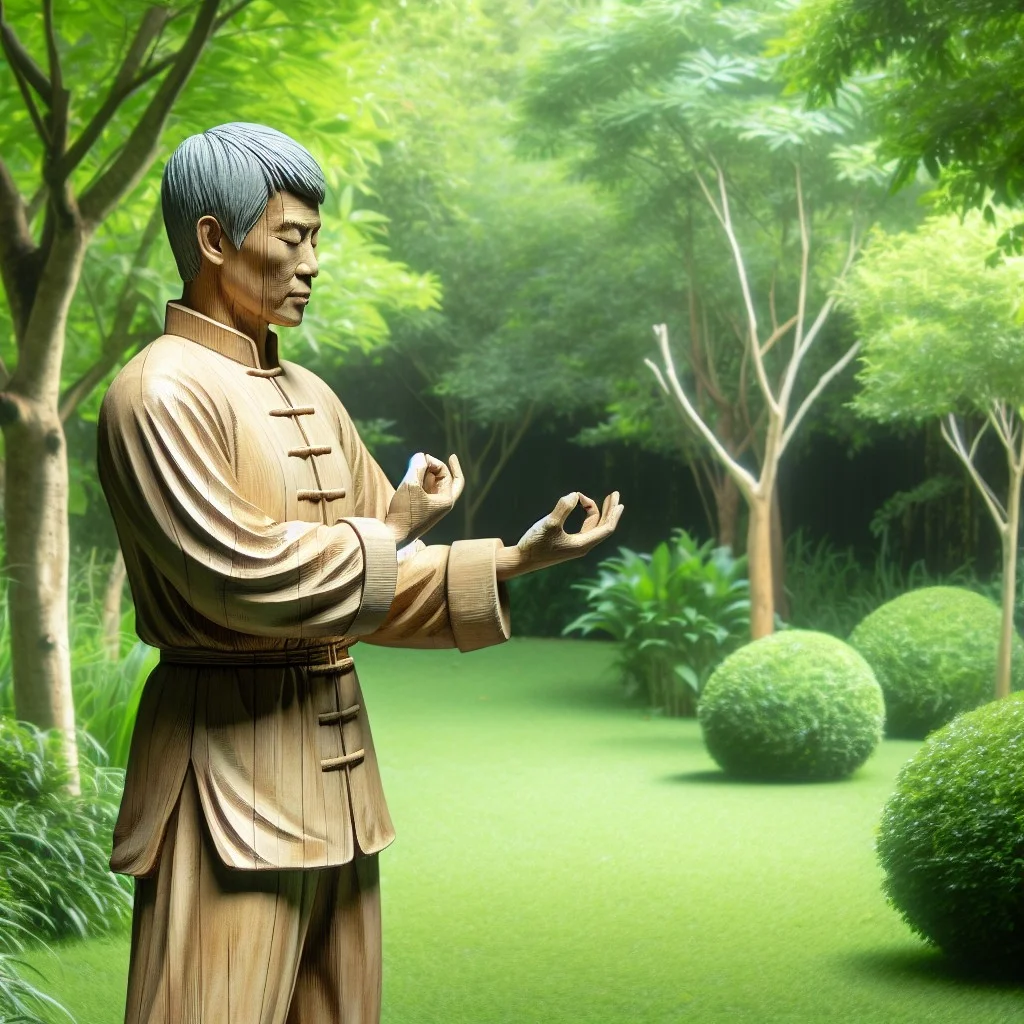Experience a fresh perspective on mindfulness because standing meditation offers unique benefits that traditional seated practices may not provide.
Standing meditation, often overlooked in favor of its seated counterpart, is a powerful practice that combines mindfulness and physical endurance. This article will guide you through the steps of standing meditation, from finding your balance to focusing your mind. It’s a comprehensive guide, detailing not only the ‘how’ but also the ‘why’ behind each step. Whether you’re a meditation novice or an experienced practitioner seeking to diversify your practice, this article provides the information you need. It’s time to stand up and meditate!
Key takeaways:
- Standing meditation combines mindfulness and physical endurance.
- Correct posture is essential for standing meditation.
- Different techniques like Zhang Zhuang and Yiquan have specific instructions.
- Standing meditation can be integrated into pre or post-workout routines.
- Benefits include anxiety control, improved sleep, and stress reduction.
Understanding Standing Meditation

While it may conjure images of stillness, the practice is far from static. The challenge lies in maintaining focus, mental clarity, and physical openness.
Each meditation session is an exercise in awareness, using sensation, perception, and cognition. This method can help build a deeper understanding of the direct link between the body and the mind, creating a clear path towards harmony and balance.
By tuning into the body and standing like a tree, practitioners can gain a sense of grounding, strengthen their focus and promote inner calm.
Ultimately, this mindfulness exercise guides individuals to a state of pure being, where they are fully present, calm, and unswayed by the external environment.
Posture for Standing Meditation

Maintaining the right posture is essential to maximize the benefits of standing meditation. Begin by standing on a flat surface. Position your feet shoulder-width apart and align them parallel to each other. Avoid locking your knees; instead, keep them slightly bent to facilitate better blood flow.
As for your upper body, keep your spine naturally straight but relaxed. Avoid slouching or arching your back too much. It’s about finding a balance in your stance that allows you to remain relaxed, yet alert.
When it comes to your arms, let them hang loosely by your sides or place them in front of you, hands resting gently one over the other at about navel level. Your shoulders should be relaxed and not hunched or tensed.
Finally, the position of your head is critical. Keep it upright, not leaning forward, backward, or sideways. Tuck in your chin slightly and gaze softly into the distance or keep your eyes closed if it feels more comfortable that way.
Remember, your stability and comfort take precedence over the strict accuracy of the posture. This practice encourages body awareness and calmness through the physical act of standing mindfully. It’s less about perfection and more about practicing mindfulness in this unique manner.
Zhang Zhuang Technique for Standing Meditation

The Zhang Zhuang approach to standing meditation is one that engages themes of grounding, stability, and patience. This is traditionally known as a form of standing like a post or tree.
1. Positioning: Primarily, the feet should be shoulder-width apart. The body weight is divided equally across both feet. This assists in evenly distributing your energy and aids in maintaining balance.
2. Body Alignment: The trunk is erect, with a slight inward curve in the lower back. Attention is given to avoid straining the neck or back. Ears aligned with shoulders and hips to form a straight line.
3. Arm Posture: Arms are slightly lifted as if they’re embracing a large beach ball at chest level. The purpose is to encourage energy flow throughout the body.
4. Breathing and focus: In this method, the breath is natural, not forced. The focus is on maintaining relaxation and silence within the body’s position. The mind’s alertness is engaged in feeling subtle movements and changes in the body.
5. Time: Typically practiced for 20-30 minutes but beginners can start with 5-10 minutes and gradually increase as comfort develops. Avoid pushing yourself to the point of discomfort.
The technique utilizes physical stillness to cultivate inner movement, pursuing calmness, clarity, and vitality through meditation.
Yiquan Standing Meditation Posture

As part of Yiquan, a Chinese martial art, the underlying aim is to foster a sense of tranquility. To accurately execute this posture, follow the steps below:
- Stand erect with feet spread slightly wider than shoulder-width apart, toes pointing forward.
- Bend your knees gently, similar to a shallow squat.
- Raise your arms at the elbow until they’re parallel to the ground, palms facing downward.
- Keep fingers softly curved as if holding a large balloon on each side.
- The head should remain straight, pretends to be suspended from above by a invisible string.
- Soften your gaze, focus on nothing particular, fostering a 360-degree type of awareness.
Remember to breathe naturally. The goal is to feel comfortable in stillness, fostering internal energy flow known as ‘Qi‘. A correct execution of this aligns your body and mind, promoting balance and tranquility.
Standing Meditation Before or After Workout
Workouts offer a perfect avenue for integrating the practice of standing meditation. This can be done either before or after the exercise regimen. Incorporating meditation in your workout can significantly enhance your mindfulness and body awareness, boosting the efficacy of your entire fitness program.
When used as a pre-workout regimen, standing meditation allows you to ground yourself, focus on your breathing, and mentally prepare for the exercise routine ahead. It equips you with the mental clarity needed to tackle challenging workout sessions.
Post-workout, standing meditation serves as an excellent cool-down strategy. It aids in calming the body, bringing attention to areas that may feel strained or tired, and promoting recovery by fostering a deep sense of relaxation. It also provides a moment to acknowledge your efforts, reinforcing positive workout habits.
You might find it more beneficial to meditate before a workout if you struggle with focus during exercise. On the other hand, if you find it difficult to unwind after exercising, you might find a post-workout meditation session more useful. Ultimately, standing meditation should seamlessly integrate into your workout routine in a way that amplifies your overall wellness.
Here are some points to remember:
- Standing meditation can act as both a pre-workout motivational boost and a post-workout cool-down strategy.
- Pre-workout meditation improves focus and gearing the body for physical exertion.
- Post-workout meditation assists in muscle recovery and stress relief, contributing to overall wellness.
- The choice between the two depends on personal preferences and workout goals.
Acupuncture Approach of Standing Meditation
In the Acupuncture approach, standing meditation leverages energy meridians connected to various organs in the body. The aim is to promote holistic balance and wellness. It suggests specific standing postures that correspond to these energy pathways. These postures allow the flow of Qi (life-force energy) through the meridians to nourish organs, stimulate natural healing and promote mindfulness.
Three primary points to understand this approach include:
- Qi Flow: Central to this approach is the concept of Qi, which should flow smoothly throughout the body for optimal health. Postures in standing meditation enhance this flow.
- Meridian Points: Different postures activate different meridian points in the body. For example, ‘Embracing the Tree’ posture stimulates lung meridian, enhancing lung function and resilience.
- Healing Process: The main goal is healing and well-being. With daily practice, blockages in energy flow are removed and diseases alleviated. Enhanced energy flow nourishes the body, boosts immunity, and fosters mindfulness.
Standing Meditation Class Overview
In standing meditation classes, the instructor will guide learners thoroughly, providing step-by-step instructions for correct positioning, starting from feet alignment up to head placement. The class typically includes various exercises adapted to different skill levels. These exercises are aimed at better body awareness, releasing tension, and promoting a deeper connection between mind and body.
1. Optimum Positioning: Instruction on the right posture is the first step in these classes. It is crucial as it holds the key to ensuring energy flow and balance.
2. Detailed Guidance: Attention is given to the minutest detail – the weight distribution on the feet, the alignment of knees and hips, relaxation of the shoulders, and positioning of the hands.
3. Body Awareness Exercises: These are designed to enhance understanding of body positioning, structure, and movements.
4. Mind-Body Connection: The classes emphasize not just the physical aspect, but also the mental and emotional – building mindfulness during practice.
5. Feedback and Corrections: Instructors monitor progress and provide personalized feedback, ensuring correct technique and posture for maximum benefits.
Participation in a Standing Meditation class can create a foundation for the practice, enabling long-lasting benefits for both mind and body.
Benefits of Standing Meditation: Anxiety Control, Improved Sleep, Mental Disorder Symptom Relief, Immune System Boost, Stress and Depression Reduction
Practicing standing meditation provides a way to manage anxiety by focusing the mind on the present moment, creating a state of tranquil co-existing with natural flows of energies and thoughts instead of being disrupted by them.
In relation to improved sleep, the stillness of the standing meditation eases tensed muscles and soothing the racing mind, promoting a night of deeper, more restful sleep.
The relief of mental disorder symptoms involves redirecting catastrophizing thoughts into nonjudgmental awareness of oneself. The very act demands mindfulness, helping individuals to process complicated emotions in a more balanced way.
Boosting the immune system is another evident benefit, as the calming nature of standing meditation reduces stress hormones in the body. This fortifies the immune response, making one less susceptible to illnesses.
Lastly, the technique affords an effective strategy for stress and depression reduction. Standing meditation enables the mind to experience serenity, breaking the continuous loop of negative thinking while centering oneself in a mindful state of being. This process lowers stress levels and aids in lessening depressive symptoms.
FAQ
Can we do meditation by standing?
Yes, meditation can be done in various postures including standing.
How long should I do standing meditation?
For achieving the health and energetic benefits, the ideal duration of standing meditation should typically be around twenty minutes.
What precautions should one take while practicing standing meditation?
One should ensure a quiet environment, comfortable clothing, and proper alignment of body postures to maintain balance and avoid physical discomfort or injury while practicing standing meditation.
Is standing meditation suitable for individuals with certain physical challenges?
Yes, standing meditation can be adjusted to accommodate various physical challenges, embracing modifications like leaning against a wall or using props for support.
How does standing meditation differ in impact compared to traditional sitting meditation?
Standing meditation, in contrast to the traditional sitting method, predominantly focuses on physical alignment and balance, leading to stronger postural awareness and muscular endurance, although they both foster concentration and mindfulness.